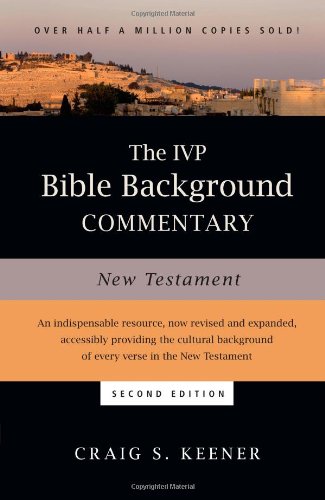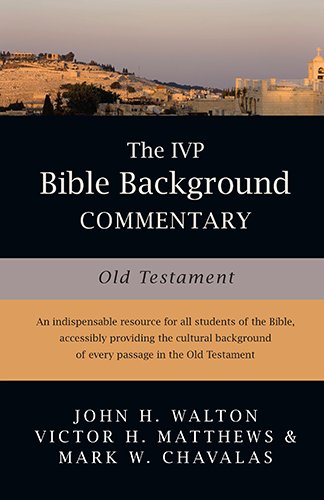C raig Keener. The IVP Bible Background Commentary: New Testament. 2nd ed. IVP Academic, 2014. 816 pages
raig Keener. The IVP Bible Background Commentary: New Testament. 2nd ed. IVP Academic, 2014. 816 pages
John Walton, Victor Matthews, and Mark Chavalas. The IVP Bible Background Commentary Old Testament. IVP Academic, 2000. 832 pages
Craig Keener’s Bible Background Commentary has sold over half a million copies. It was first published in 1993 and has been of great assistance to students and pastors for a quick reference to the background issues at stake in a certain passage. What’s the deal with head coverings? Baptism for the dead? Who are the Epicureans? What was Ephesus like, and what is the Temple of Artemis? These are questions that you could certainly Wikipedia in a jam, but why not allow a seasoned scholar who focuses on NT background explain it for you? And he does it in one not-so-large volume!
 Keener has now updated and re-issued his NT volume with some additional documentation and some updated sections, based on knowledge he has gleaned for the past two decades. But this work still serves a popular audience and lacks most documentation for his statements. He points the reader to his critical commentaries on Matthew, John, Acts, Romans, and others for documentation that stands behind his research, but the reader can be assured that in a popular work such as this, Keener will likely not lead the reader astray with factual errors. One quick glance at the footnotes of his new Acts commentary is enough to demonstrate the depth and breadth of Keener’s research in both the Jewish and the Greco-Roman world.
Keener has now updated and re-issued his NT volume with some additional documentation and some updated sections, based on knowledge he has gleaned for the past two decades. But this work still serves a popular audience and lacks most documentation for his statements. He points the reader to his critical commentaries on Matthew, John, Acts, Romans, and others for documentation that stands behind his research, but the reader can be assured that in a popular work such as this, Keener will likely not lead the reader astray with factual errors. One quick glance at the footnotes of his new Acts commentary is enough to demonstrate the depth and breadth of Keener’s research in both the Jewish and the Greco-Roman world.
But Keener does not only provide background on individual verses. He also includes introductions to each book in the NT, and orientations to reading the various genres. So, for example, in introducing John’s Gospel, he includes discussion on authorship, date, provenance, setting, genre, message, and commentaries for further reading. But at the beginning of the Gospels section, he also includes discussion on the “genre” of Gospels (although that’s a complex issue to refer to “Gospel” as a genre) and how to read them. In this way, he covers a lot of the ground that a book such as David Aune’s does, The New Testament in its Literary Environment, but in a much briefer and more accessible manner. This commentary is absolutely indispensable for the library of the pastor, student, and layman. Hopefully, this second edition will be as successful as the first.
Alongside Keener’s volume is the companion volume to the OT. These three scholars are no slouches either, and are well-known for their historical backgrounds work in the OT, especially ANE documents. Similar to Keener’s volume, each section of the OT receives its own introduction, but it is not as extensive as Keener’s and tends to focus more on the books included within that section rather than issues such as genre, hermeneutics, and recent scholarship. One exception is the introduction to the psalms, which has a very helpful orientation to “common concepts” such as acrostics, the afterlife, creation, lament, praise, etc. The section on musical terms is also resourceful, packing in an explanation of all the terms used in the psalter in just two accessible pages. Where there is overlap with ANE psalms or poetry, the authors explain.
There are some warnings to heed before devouring these volumes whole-heartedly, however. Historical backgrounds are necessary for doing proper biblical research. One could not even translate the original languages if we did not do rigorous historical research in both Hebrew and other ANE cultures. The meaning of many Hebrew words is still uncertain, for example, and we continue to research other related languages and cultures to understand the meaning of these terms more precisely. But historical backgrounds can also be misused if the methodology is flawed. For example, one era of comparative ANE-OT studies tried to fit everything from the OT into patterns of religion from other ANE cultures. On the other hand, conservatives tried to show the absolute distinctiveness of Israel’s Scriptures and religion. Later, in a sort of Hegelian dialectic, many scholars settled into a pattern of compare and contrast, where they would recognize elements of similarity and dissimilarity between Israel and her neighbors. Some scholars are trying to be even more sophisticated now in their comparative method, but the job is difficult, especially when so much data is lacking and conjecture must often be used.
To give one practical example of this, the authors note on p. 211 that “Israel’s historiography holds much in common with neighboring ancient cultures.” This may be very true, or may be partially true. It all depends on one’s methodology for comparative studies. If one holds that Israel’s historiography will look like their neighbors’, then one will read it like their neighbors’. Many “problems” in Israel’s historiography are explained by noting the lack of care for historical precision in historiography, much like their neighbors. Historiography was driven by ideologies and it causes the “facts” (if there be such a thing!) to be skewed. Most people would accept these statements to some extent, but the issue is how far this is taken.
With background commentaries, one must beware that one doesn’t accept that Israel’s Scriptures necessarily mimic the writings of the ANE or of Greco-Roman culture in every way. It can differ, and does in many ways. But it is also quite the same. There are similar worldviews. When healings occur in the Gospels, likely no Jewish person doubted that Jesus actually healed people, since there were other healers in that time period and region, and their worldview was able to fit in miracles. When Greeks who believed (to some extent) in the Homeric myths read of Yahweh parting the Red Sea, they likely had no issue with the possibility of it happening. Their question would have likely been, “ok, but is Yahweh stronger than Zeus?” So, without resolving all the methodological issues involved, I leave the reader with some cautions about the issues, and the admonition to think carefully about historical backgrounds and about how the Bible compares and contrasts with extra-biblical documents.
With this methodological warning in mind, I do highly recommend these commentaries. I consulted Keener’s first edition myself often, and the second addition, as well as the OT volume, will continue to be a quick reference for me. Of course, if you’re doing research, you will need to do further research to confirm their conclusions in primary sources since they do not document them, but they can be a helpful launchpad to give you a direction for your research. Give both volumes a preview on Amazon or buy them, Keener’s volume here, and the OT volume here.
For another post on these commentaries that looks at a specific example of an OT background that the commentary gets wrong, and thus an admonition to always check the primary sources yourself, see my post at Books At a Glance.
